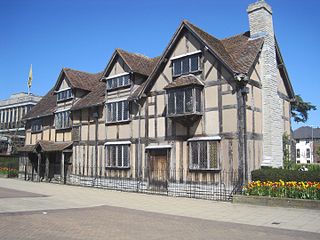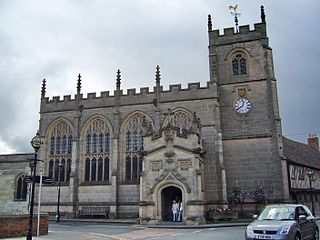
Stratford-upon-Avon, commonly known as just Stratford, is a market town and civil parish in the Stratford-on-Avon district, in the county of Warwickshire, in the West Midlands region of England. It is situated on the River Avon, 91 miles (146 km) north-west of London, 22 miles (35 km) south-east of Birmingham and 8 miles (13 km) south-west of Warwick. The town is the southernmost point of the Arden area on the edge of the Cotswolds. In the 2021 census Stratford had a population of 30,495.

John Shakespeare was an English businessman and politician who was the father of William Shakespeare. Active in Stratford-upon-Avon, he was a glover and whittawer by trade. Shakespeare was elected to several municipal offices, serving as an alderman and culminating in a term as bailiff, the chief magistrate of the town council, and mayor of Stratford in 1568, before he fell on hard times for reasons unknown. His fortunes later revived and he was granted a coat of arms five years before his death, probably at the instigation and expense of his son, the actor and playwright.

Hugh Clopton was a Lord Mayor of London, a member of the Worshipful Company of Mercers and a benefactor of his home town of Stratford-upon-Avon in Warwickshire.

Shirley is a town in the Metropolitan Borough of Solihull, in the West Midlands, England. Historically part of Warwickshire, neighbouring districts include Shirley Heath, Sharmans Cross, Solihull Lodge, Monkspath,Cheswick Green Cranmore and the Hall Green district of Birmingham.

New Place was William Shakespeare's final place of residence in Stratford-upon-Avon. He died there in 1616. The whole building was demolished by Francis Gastrell, vicar of Frodsham, Cheshire, in 1759. It was never rebuilt and only the foundations remain.

Wootton Wawen is a village and civil parish in the Stratford-on-Avon district of Warwickshire, England. The village is on the A3400 in mid-western Warwickshire, about 20 miles (32 km) from Birmingham, about 2 miles (3 km) south of Henley-in-Arden and about 6.5 miles (10 km) north of Stratford-upon-Avon. The soil is a strong clay and some arable crops are grown, but the land is mainly in pasture. The common fields were inclosed in 1776, but some inclosures had already been made about 1623.

The Collegiate Church of the Holy and Undivided Trinity, Stratford-upon-Avon, is a Grade I listed parish church of the Church of England in Stratford-upon-Avon, Warwickshire, England. It is often known simply as Holy Trinity Church or as Shakespeare's Church, due to its fame as the place of baptism, marriage and burial of William Shakespeare. More than 200,000 tourists visit the church each year.

Henley-in-Arden is a town and civil parish in the Stratford-on-Avon District in Warwickshire, England. The town takes its last name from the former Forest of Arden. Henley is known for its variety of historic buildings, some of which date back to medieval times, and its wide variety of preserved architectural styles. The one-mile-long (1.6 km) High Street is a conservation area.

The Lord Leycester Hospital is one of the best preserved examples of medieval courtyard architecture in England and is a charity supporting ex-servicemen. It is located in Warwick, England, next to the West Gate, on High Street. It is a Grade I listed building. The Hospital is a prominent and internationally famous feature of Warwick. For almost 900 years buildings have been erected and civic activity has taken place on the site, starting with the chapel built in 1126. The site was donated by the 12th Earl of Warwick in the 14th century to the United Guild of the Holy Trinity and St George. The Guild Hall, Great Hall and Master's House were constructed in the late 15th century. Over the centuries, the ancient buildings and 500 year old gardens have been admired by many famous visitors such as Charles Dickens and Oscar Wilde, by Kings and Queens, such as King George V and the Queen Mother and ordinary travellers from around the world.

The Grammar School of King Edward VI at Stratford-upon-Avon is a grammar school and academy in Stratford-upon-Avon, Warwickshire, England, traditionally for boys only. However, since September 2013 the school has admitted girls into the Sixth Form. It is almost certain that William Shakespeare attended this school, leading to the school widely being described as "Shakespeare's School".

Hockley Heath is a large village and civil parish in the Arden area mostly within the Metropolitan Borough of Solihull, West Midlands, England. It incorporates the hamlet of Nuthurst, and has a history dating back to the year 705 AD as a wood owned by Worcester Cathedral. The parish, known as Nuthurst cum Hockley Heath, is to the south of the West Midlands conurbation, 12 miles (19 km) southeast of Birmingham 5.5 miles (8.9 km) from Solihull town centre and 12.5 miles (20.1 km) north of Stratford-upon-Avon. The village forms part of the border with Warwickshire and the District of Stratford-on-Avon to the south, with some parts of the village on either side of the border. According to the 2001 census, the parish had a population of 6,771, being measured at the 2011 Census as 2,038.

Kinwarton is a village in the valley of the River Alne, Warwickshire, to the north-east of the market town of Alcester. The population of the civil parish at the 2011 Census was 1,082. The ground is mostly low-lying, with a maximum altitude of 206 ft. and some of the fields near the river are liable to floods. The road from Alcester to Henley-in-Arden runs through the middle of the parish. A branch road leads off to the church and rectory about a quarter of a mile to the south and thence continues as a field-path down to a ford across the River Alne below Hoo Mill. From the north side of the main road a by-road branches off to Coughton.
Luddington is a small village and civil parish in the English county of Warwickshire and is part of Stratford-on-Avon district. The community is a conservation area due to its historic aspects. In 2001, the population was 457, increasing to 515 at the 2021 Census. It is located about 5 kilometres outside the town of Stratford-upon-Avon on the banks of the river Avon and has views south over the Cotswolds. Facilities and communications include a phone box, a 19th-century church, a post box, a marina with a 17th-century lock, a village green and a recently refurbished village hall originally built in 1953. The parish encompasses Dodwell Caravan Park to the north of the village. The village is reputed to be the meeting place of Anne Hathaway and William Shakespeare, as Anne was from the parish, and local lore states that they probably conducted their courtship in the area.

The Shakespeare Birthplace Trust (SBT) is an independent registered educational charity based in Stratford-upon-Avon, Warwickshire, England, that came into existence in 1847 following the purchase of William Shakespeare's birthplace for preservation as a national memorial. It can also lay claim to be the oldest conservation society in Britain. Receiving no government funding or public subsidies, it is totally dependent upon the public for support, and relies on donations and the income generated from visitors.
Dr. Levi Fox OBE, DL, MA, FSA, FRHistS, FRSL, was the son of a Leicestershire smallholder. He became Archivist for the city of Coventry and then Director of the Shakespeare Birthplace Trust, and was a conservationist, local historian, and author.

Shakespeare's Birthplace is a restored 16th-century half-timbered house situated on Henley Street, Stratford-upon-Avon, Warwickshire, England, where it is believed that William Shakespeare was born in 1564 and spent his childhood years. It is now a small museum open to the public and a popular visitor attraction, owned and managed by the Shakespeare Birthplace Trust.


The Guild Chapel of the Holy Cross, Stratford-upon-Avon, Warwickshire is a chapel of 13th century origins. Founded by the Guild of the Holy Cross before 1269, it passed into the control of the town corporation in 1553, when the Guild was suppressed by Edward VI. The chapel stands on Church Street, opposite the site of William Shakespeare's home, New Place, and has historic connections to Shakespeare's family. The chapel was gifted an extensive series of wall-paintings by Hugh Clopton, an earlier owner of New Place, and John Shakespeare, Shakespeare's father, undertook their defacement in the later 1500s. The paintings have recently been conserved.

Stratford-upon-Avon Guildhall is a historic building in Church Street, Stratford-upon-Avon, Warwickshire, England. It is a Grade I listed building. Dating from the early 15th century, the Guildhall was for centuries at the centre of life in Stratford, being used for assemblies, as a meeting place for the local council, and as a school building for the King Edward VI School. Most famously William Shakespeare almost certainly attended school here. The building was opened to the public in 2016, after being restored.

The Guild of the Holy Cross was a medieval religious guild in Stratford-upon-Avon, which was created in 1269, and abolished in 1547. Throughout the period of its existence, the guild was a central institution of Stratford's civic and cultural life, which catered for the town's spiritual needs and fulfilled a range of political and social functions. A number of historical buildings associated with the guild still survive today.






















